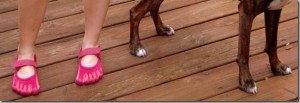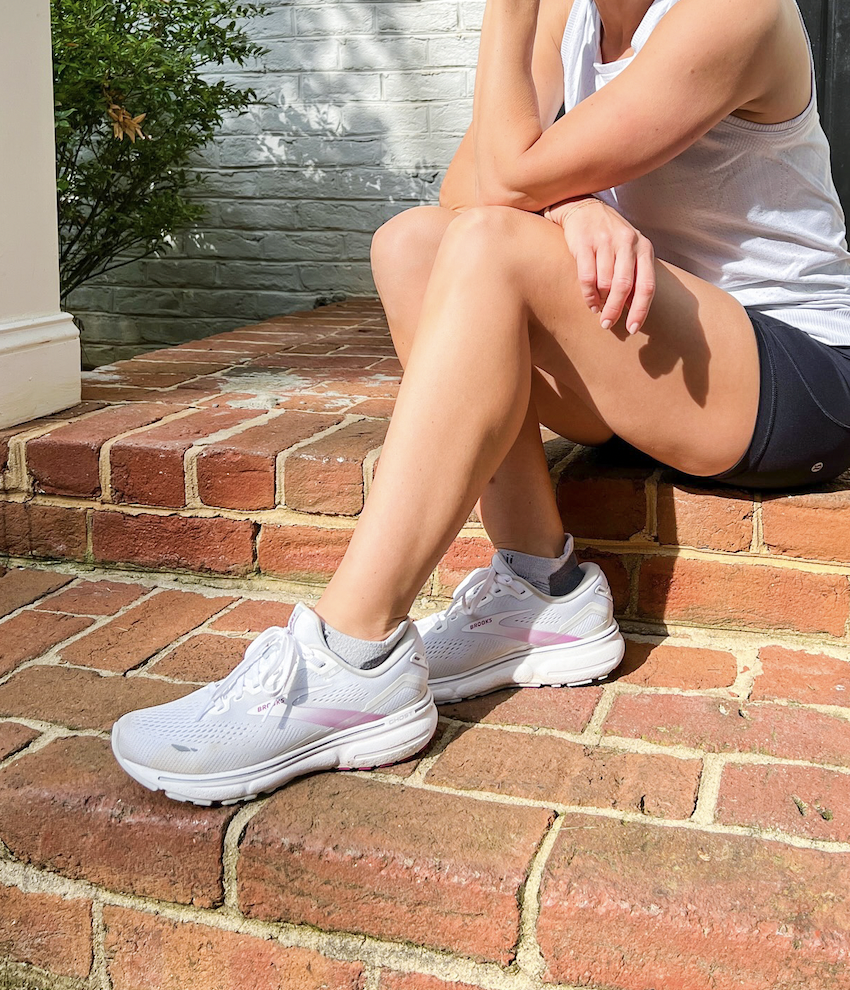


We runners love our shoes. And for good reason: they keep us comfortable and strong on the roads, and we wear them daily, so it’s nice when they’re cute too.
But if you’re new to running, the variety of running shoes on the market can be intimidating. How do you know which type to wear and when? What even are the different types? Is one brand better than the next? In today’s post, I’m going to give you a quick rundown (pun intended) of the main categories of running shoes and share my top pick for each.
For context, I run in Brooks, New Balance, Adidas, and sometimes Nike. I always get professionally fitted at a running store like Fleet Feet when I’m buying a new pair of running shoes, and I HIGHLY recommend you do that too. Knowing the categories below is helpful, but a professional can help you determine which type you need. They’ll analyze your gait and get you to try on a variety of shoes. They’ll watch you walk and jog in them to help you figure out your best option.
First up, trainers! Trainers are your day-to-day go-to shoe for your easy mileage needs. These are the shoes you’ll likely spend the most time running in, so it’s important to make sure that they fit comfortably and feel good for each run. When it comes to picking the perfect pair of trainers for your feet, there are several sub-categories to from: stability shoes, neutral shoes and minimalist shoes. Here’s a quick rundown on each.
Stability trainers are often considered the clydesdales of the running shoe world. These shoes usually sport a lot of dense, hard foam around the sole. The purpose of this foam is to provide support for feet whose arches are weaker or prone to collapse. Some stability shoes also emphasize ankle support, locking the joint in place to prevent over-pronation. (Pronation refers to when your feet roll inward as you push off the ground).
These are great for people who over-pronate and they should last for a good while. The only cons are that they can be heavy, and can sometimes really mess with a runner who already has strong ankles and arches.
A great stability shoe on the market right now is the Brooks Adrenaline.
Neutral trainers are the most popular running shoes on the market. They’re made for the widest range of feet possible, and they work well for a large group. These feature an even distribution of light foam around the entire shoe, which provides some basic cushion without too much padding. As a result, they’re a perfect starting point if you’re just getting into running and don’t yet know the particulars of your gait.
As far as lifespan is concerned, neutral shoes are the Goldilocks option: they hold up to a decent block of mileage (around 400-450 miles), without the additional weight that comes from heavy duty structure.
My top pick for a neutral trainer is the Brooks Ghost (I personally run in these!).
Minimalist shoes skyrocketed in popularity after the release of Christopher McDougall’s 2009 bestseller Born to Run. They aren’t as popular anymore, but there are still things to love about a minimalist shoe. The main difference between these streamlined trainers and their counterparts is the amount of cushion. Minimalist shoes offer very little supportive foam. This can be great for lower mileage runners, mid-foot strikers, or athletes with very strong feet and ankles. However, these shoes tend to break down quickly, and the lack of support can pose a risk to the injury-prone among us.
However, a shoe like this is typically a “faster” shoe, meaning you get quicker turnover in them because they are light. I wear a minimalist shoe when I’m running a road race or doing a workout.
The pair I wear is the Brooks Hyperion Tempo. They’re SO great, but not the best option for someone who is only looking to get 1 pair of running shoes.
Trail running shoes are what they sound like: running shoes for trail running. Because trails have tougher topography, trail shoes have a couple of key components that make them suited to handle that. First, their outsoles are bigger and squishier than your average running shoe. This extra material prevents them from breaking down quickly, and the soft rubber allows them to bend around stones, sticks, and roots on rugged trails. Trail running shoes also have stiff midsoles for structured support to protect your arches. Finally, they sport reinforced uppers that, while less breathable than typical trainers, offer defense against sharp twigs and brambles.
Obviously, trail shoes are more specialized than regular trainers; they’re fantastic for gnarly surfaces, but not practical on the roads. I’d recommend investing in a sturdy pair of trail shoes only if you are training specifically for a trail race or doing the bulk of your running off the beaten path.
Since I spend a lot of time in Boone, NC, I’ve decided to invest in some Altra Lone Peak trail shoes for my trail running.
When elite athletes begin a hard workout or toe the line at a major road race, you can pretty much guarantee they’ll be wearing flats. These shoes are all about speed: think Ferrari as opposed to a mini van.
Racing flats look a bit like minimalist trainers superficially. They’re lightweight, low cushion, and generally streamlined. Most racing flats come equipped with some combination of high-grip outsoles (for traction on slick roads) and a speed board (to spring your foot forward as you run).
I don’t recommend buying these unless you’re racing frequently. My pick would be the Nike Vaporfly.
Spikes are the fastest shoe on this list, and they are built for maximum traction on soft surfaces. Think college or high school cross country races that take place on a dirty course, versus a road. Their outsoles are cratered with a series of evenly spaced pits, into which a metal “spike” implement can be fastened. The spikes can be anywhere from 1/16th of an inch to nearly a full inch long. The shoes actually look more like a sock than a shoe, and they aren’t necessarily comfortable, but they do get the job done.
There aren’t a lot of downsides to wearing spikes for spike-appropriate races, except that they can be hard on calves or toes. I wouldn’t recommend wearing them for distances much further than 10k.
New Balance makes a great spike shoe called the FuelCell MD-X.
When it comes down to it, the correct type of running shoe depends on the situation – whether that’s flats for a road race, spikes for the track, trail shoes for wilderness, or a comfy trainer for daily use.
And ultimately, the “best” version of each is the one that you don’t notice when you run. Because that’s really what shoes are for: allowing you to reach your running goals without slowing you down.
What do you run in? What do you like about them?
Shop The Post


Leave a Comment
One response to “Running Shoe Types and When to Wear Them”
[…] you’ve never used running as a way to stay fit, here’s a great guide on which are the best shoes to wear. There is also a great article on what every runner needs that I suggest you check […]